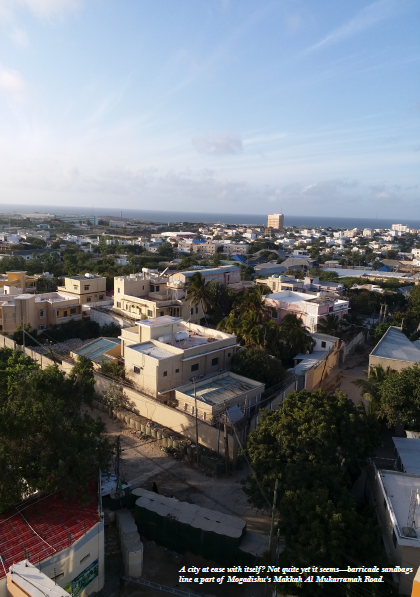A journey of a thousand miles, goes the Chinese proverb, begins with a single step. After a long absence, I boarded a plane and made a trip to Mogadishu. Immediately, one is met by a city of contrasts: one seeped in its history, maintaining a link with its distant past, but one also transformed, changed and in some parts still scarred by recent decades. When I was last there—where I had once seen a dilapidated city, its bullet-ridden buildings a close resemblance of baghrir, Algerian ‘thousand-hole pancakes’ so-called because of their appearance—I now saw a lively city, vibrant, dynamic. New housing developments are rising in different parts of the capital, like a pimple outbreak, privately-funded ventures for those looking to capitalise on the stable but still fragile peace that now inhabits the city’s streets. Businesses are springing up too, operating in a marketplace which is still largely unregulated, beyond the state’s purview.

Older parts of the city look worse for wear, the result of a confluence of factors: rather naturally, age has taken its toll on them, exacerbated by the fact they were built many decades, or in some cases centuries, ago. The signs of war are evident on them too. The bruising effects of humidity have played their part; since Mogadishu is in the coastal Banadir region, perched on the Indian Ocean, it experiences higher levels of humidity than inland, which typically runs at seventy percent even during the dry seasons. Public transport is very much in operation. Well-serviced minibuses are complemented on the city’s streets by the increasingly ubiquitous “tuk tuk”, the auto trishaw, both in word and concept a loan from southeast Asia. These serve the public at low cost. Movement within the city is good except at crossroads. There, due to the lack of traffic controls, motorists struggle to navigate the clogged streets, which, at peak hours, are filled beyond their capacity. The main streets are bustle with people and their energetic chatter. Many―like one of the capital’s busiest roads, Makkah Al- Mukarramah Road— were rebuilt by the Turkish Government and the Mogadishu Municipality and are lighted by solar street lights at night. The latest pickups and 4WD car models are common. Many are armoured, which is a new phenomenon. Guns are largely only carried by the state security personnel and security companies.

 it is still expensive, hindering industrial development. The city’s settlements are polarised on a clan basis. This city, which was once highly cosmopolitan, has been fractured into separate suburbs. Movement within the city is normal enough, but due to the sense of insecurity, people tend to coalesce to where their sub-clans live. In the long term this is not good for a city which has a long, vibrant history. If the city is to regain its old splendour, it will have to embark on a long journey. But every journey surely does begin with a single step.
it is still expensive, hindering industrial development. The city’s settlements are polarised on a clan basis. This city, which was once highly cosmopolitan, has been fractured into separate suburbs. Movement within the city is normal enough, but due to the sense of insecurity, people tend to coalesce to where their sub-clans live. In the long term this is not good for a city which has a long, vibrant history. If the city is to regain its old splendour, it will have to embark on a long journey. But every journey surely does begin with a single step.